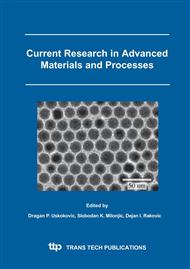p.339
p.345
p.351
p.357
p.363
p.369
p.375
p.381
p.387
Characterization and Catalytic Activity of Poly(4-Vinylpyridine-Co-Divinylbenzene)-Co2+ Complex
Abstract:
Poly(4-vinylpyridine-co-divinylbenzene)-Co2+ was characterized using infrared spectroscopy (IR), thermogravimetric analysis (TG-DTA), N2-physisorption and polarography. Thermal analysis suggests sufficient thermal stability of the polymer support, under reaction conditions. From polarography measurements, the Co2+ content on polymer-supported catalysts is estimated and it was proved that no significant leaching occurred during the activity tests. At the molecular level, FTIR of P4VP-DVB-Co2+ reveals that the pyridine nitrogen lone pair coordinates to the metal center in the polymeric complex. The obtained P4VP-DVB-Co2+ catalysts performed interesting catalytic activity in reaction of the cyclohexane oxidation with air, indicating that increasing Co2+ content lowers the initiation temperature and raises the decomposition of cyclohexylhydroperoxide.
Info:
Periodical:
Pages:
363-368
Citation:
Online since:
September 2005
Authors:
Price:
Сopyright:
© 2005 Trans Tech Publications Ltd. All Rights Reserved
Share:
Citation:


